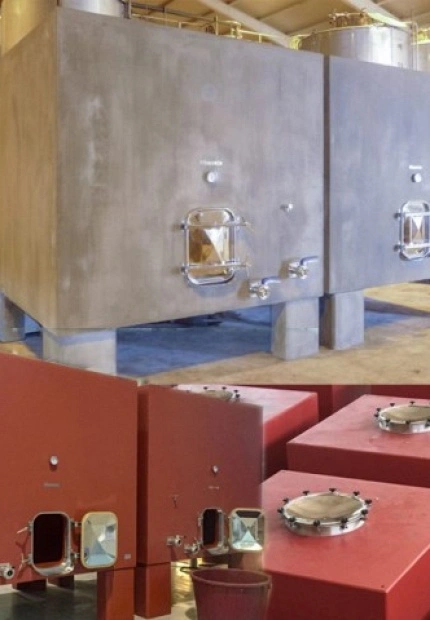The concrete tank and the wine.
The concrete tank and the wine.
Wine fermentation in concrete tanks is a fascinating process that combines winemaking tradition with innovation in winemaking tank design. Concrete tanks have gained popularity in recent years due to their unique properties that influence the quality and character of wine. In this article, we will explore in detail how this process is carried out, its benefits, and why some winemakers prefer this method.
At the heart of winemaking is fermentation, a biochemical process that transforms grape must into wine. For centuries, winegrowers have used a variety of containers to carry out this transformation, from clay amphorae to oak barrels. However, today, concrete tanks have emerged as an attractive option.
These deposits offer a number of unique advantages. Firstly, concrete is porous, which allows controlled micro-oxygenation of the wine during fermentation. This can result in greater aromatic complexity and greater color stability in the final wine. Additionally, concrete maintains a more constant temperature, providing a more controlled fermentation environment compared to other materials.
The design of concrete tanks also plays a crucial role. The shape and size of the tank can affect the extraction of phenolic compounds from grape skins, influencing the flavor and texture profile of the wine. Some tanks are coated with epoxy to prevent interaction between the wine and the concrete, while others rely on the porosity of the material to contribute to the complexity of the wine.
The choice of concrete type is also essential. Some winemakers prefer traditional concrete, while others opt for modified versions with additives that can affect the wine's characteristics. The key is to find the right balance between the properties of the concrete and its impact on the organoleptic profile of the wine.
During fermentation in concrete tanks, the yeasts present in the must begin to transform sugars into alcohol and carbon dioxide. The porosity of concrete allows this gas to be released gradually, avoiding abrupt release problems that can occur in other types of containers. Furthermore, the constant temperature of the concrete favors a slow and controlled development of the flavors and aromas of the wine.
An interesting aspect of fermentation in concrete tanks is its ability to highlight the specific characteristics of the terroir. By allowing a more subtle interaction between wine and container, the unique identity of the grape and wine region can be preserved. This approach aligns with the growing trend toward wines that authentically reflect their place of origin.
In terms of sustainability, concrete tanks also have advantages. Unlike oak barrels, which have a limited lifespan, concrete tanks are durable and require less maintenance. Additionally, the concrete manufacturing process can be less energy intensive compared to the production of wooden barrels.
Despite all these advantages, fermentation in concrete tanks is not the ideal choice for all types of wines. Some winemakers prefer the influence of wood in certain styles, and stainless steel tanks remain popular for white wines and other styles that benefit from a more neutral environment.
In conclusion, wine fermentation in concrete tanks is a complex process that combines science, art and innovation. These tanks offer winemakers the chance to experiment with various factors that affect wine, from the porosity of the concrete to the design of the tank. As the wine industry continues to evolve, it is exciting to watch winemakers leverage these tools to create wines that reflect not only the quality of the grape, but also the unique influence of concrete vats on the fermentation process.

